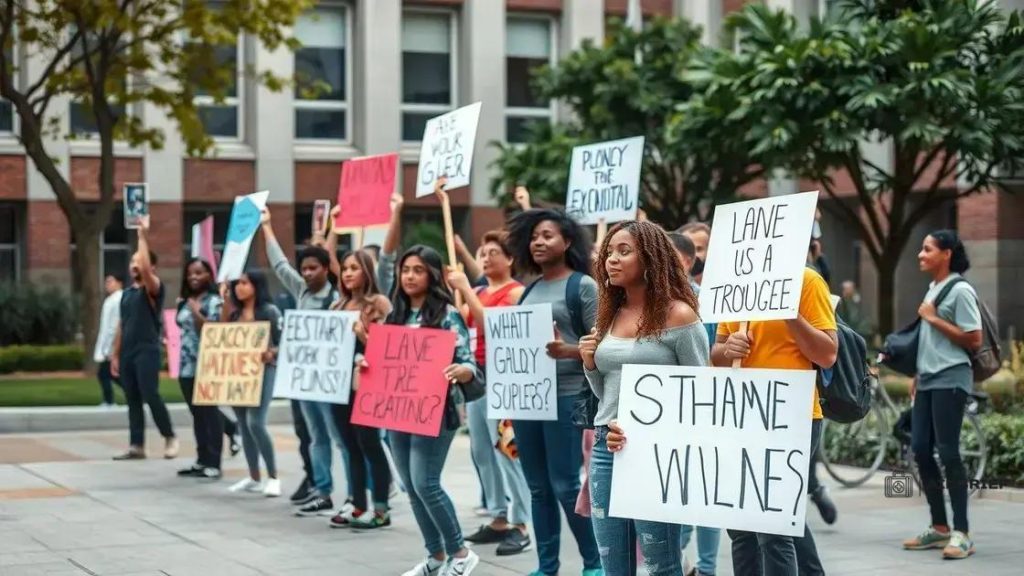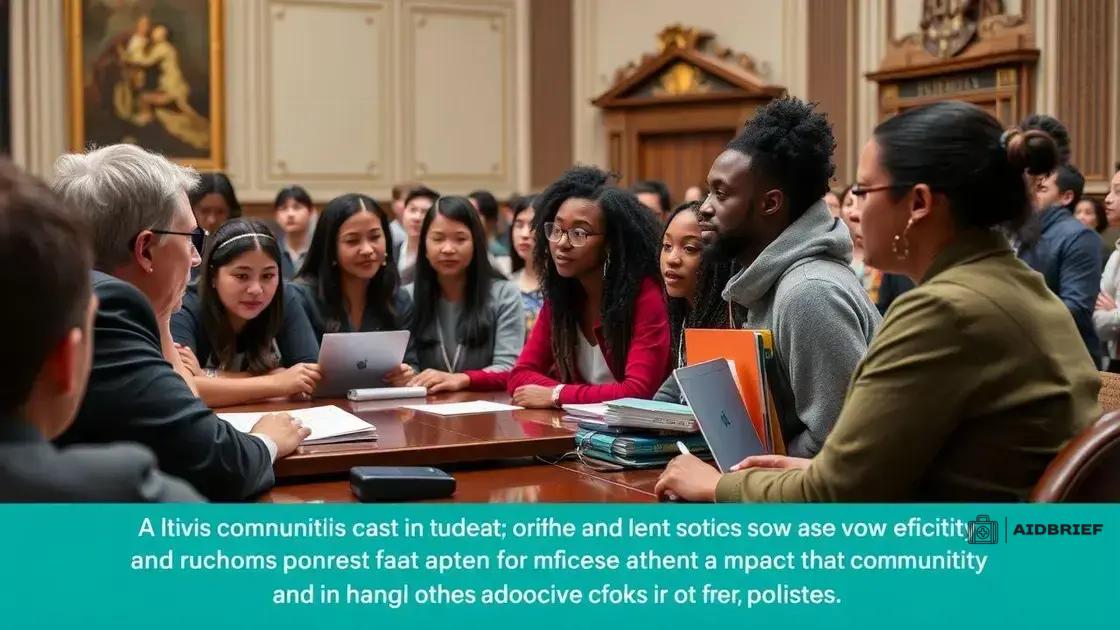Student activism events surge nationwide: what’s driving it?

Student activism events surge nationwide as young people utilize social media and technology to advocate for social change, focusing on issues like sustainability, social justice, and mental health awareness.
In recent years, student activism events surge nationwide has captured the attention of many. As students rally for change on pressing issues, it’s fascinating to see what fuels this movement. Let’s dive into what’s happening and why it matters.
Understanding the rise of student activism
The recent years have seen a significant shift in how students express their voices through activism. Understanding the rise of student activism allows us to comprehend the factors influencing this powerful wave of change.
Students today are more connected than ever, which fuels their desire to address societal issues. Their voices resonate through social media platforms, mobilizing large groups swiftly.
Key Factors in Student Activism
Several elements play a vital role in driving this movement. Here are some key factors:
- The increasing awareness of social justice issues, from climate change to racial equality.
- Access to real-time information that highlights injustices and inspires action.
- A sense of community among students, fostering collaboration and shared goals.
- The influence of activist organizations supporting youth-led initiatives.
Each of these factors contributes to a broader understanding of the energy behind student activism. For instance, many students take inspiration from historical movements, adapting their strategies to fit modern platforms.
The Role of Education
Education plays a crucial part in shaping students’ perspectives. Schools and universities often encourage critical thinking, pushing students to question the status quo. This educational environment cultivates an atmosphere where activism thrives.
Moreover, various extracurricular activities, such as debate clubs and community service projects, provide students with tools to engage effectively with their communities. Students feel empowered to make their voices heard.
In conclusion, the rise of student activism isn’t just a trend; it’s a reflection of the changing world in which young people live. As they continue to advocate for their beliefs, it’s clear that their impact will resonate for years to come.
Key events shaping the dialogue
Several significant events have played a crucial role in shaping the dialogue around student activism. By highlighting these key moments, we can better understand the evolution of this movement. In recent years, young people have mobilized around various issues that resonate deeply with their peers.
Milestone Events
Events around the world have sparked discussions and inspired students to take a stand. Here are some major instances:
- The March for Our Lives in 2018, focusing on gun reform.
- The global climate strikes, initiated by Greta Thunberg, highlighting climate change.
- The Black Lives Matter protests, advocating for racial justice.
- The Women’s March, promoting gender equality and women’s rights.
These instances illustrate how students can unite to bring attention to pressing issues. By participating in these events, students often develop a clearer vision of their goals and strategies. Their involvement deepens their understanding of the issues and amplifies their voices.
Additionally, many students use social media to share their experiences during these events. This real-time communication not only connects them with a broader audience but also encourages others to join in their causes. As students express their concerns, they create a ripple effect, inspiring further activism across campuses and communities.
Community and Support
Support from the community often enhances the impact of these key events. Local organizations, parents, and faculty members frequently play an active role in encouraging student participation. When students feel backed by their communities, they tend to be more courageous in advocating for their beliefs.
Moreover, educational institutions have begun to recognize the importance of student activism. Many schools offer programs and resources to help students organize events and express their views constructively. This support helps to cultivate an environment where student voices can thrive.
Impact on legislation and policy

The impact on legislation and policy due to student activism is significant and often transformative. As students raise their voices, they influence lawmakers and policymakers to take action on pressing issues.
A notable example is the way student-led movements have prompted discussions on gun control after tragedies like school shootings. This activism has led to proposed laws aimed at improving safety in schools.
Successful Legislative Changes
Years of consistent activism have resulted in several successful changes in legislation. Here are some impactful actions:
- Increased funding for mental health resources in schools.
- Stricter gun control measures in various states.
- Legislation aimed at addressing climate change initiatives.
- Policies supporting racial and gender equity in education.
These changes highlight how student voices can drive critical shifts in policies affecting their lives. Increasingly, lawmakers recognize that students are not just future leaders but also powerful advocates for change today.
Moreover, students often collaborate with various organizations to further their causes. These partnerships can amplify their messages and make it easier to reach broader audiences. When students and organizations unite for a cause, they employ stronger collective efforts, which can lead to significant advancements.
Engaging with Policymakers
Engagement with policymakers is key for students striving to influence legislative change. Many students participate in lobbying events or meet with local representatives to voice their concerns directly. By articulating their demands clearly, students can make legislators aware of the urgency surrounding specific issues.
Through town hall meetings and public forums, students present their views and experiences. This interaction allows them to build relationships with policymakers, fostering a sense of collaboration that enhances the chances of effective change.
Role of social media in mobilization
The role of social media in mobilization cannot be overstated. Social media platforms have changed how students organize, communicate, and advocate for their causes. These tools empower students to connect with one another quickly and effectively.
Students leverage social media to spread awareness about important issues. By sharing posts, videos, and live streams, they create a sense of community among like-minded individuals. This virtual space helps build enthusiasm and encourages participation in various events.
Key Features of Social Media for Activism
Several features of social media make it a powerful tool for mobilization:
- Instant communication allows for quick updates and mobilization efforts.
- Viral trends can spread a message widely, reaching a large audience.
- Opportunities for networking with other activists and organizations.
- Platforms for storytelling that highlight personal experiences and inspire others.
These elements help foster a robust activist culture. Social media also provides a platform for marginalized voices that may not be heard in traditional media. As students share their stories, they create compelling narratives that resonate with audiences, amplifying their calls for change.
In addition, hashtags have become a unifying theme for many movements. By using specific hashtags, students can join conversations easily and connect their efforts to larger campaigns. This strategy helps keep issues trending in public discourse, ensuring their messages are not easily forgotten.
Impact on Engagement
The impact of social media on engagement is profound. Students often organize events like rallies and protests through social media invites. These platforms not only help in planning logistics but also in rallying support, boosting attendance at events.
Moreover, social media’s interactive nature allows for direct engagement with followers. Students can respond to questions, address concerns, and gather feedback in real-time. This interaction creates a dynamic environment where participants feel valued and connected to the movement.
Future of student activism initiatives
The future of student activism initiatives looks promising as more young people engage in advocating for social change. With technology continuing to evolve, students will have even more tools at their disposal to promote their causes.
One major trend is the focus on sustainability and climate change. Students increasingly realize that their voices are essential in shaping environmental policies. Many school organizations are already leading the charge, pushing for greener practices within campuses.
Emerging Trends
Several emerging trends point to the future of student activism:
- More collaboration between universities and local communities.
- Increased emphasis on mental health awareness and related policies.
- Utilization of innovative technologies for mobilization and outreach.
- Growth in intersectional movements that address various social issues.
Students are also forming alliances with non-profit organizations and local businesses to maximize their impact. By working together, they can pool resources and share strategies that drive effective change.
Additionally, the rise of digital platforms will keep enhancing activism. Platforms like TikTok, Instagram, and Twitter not only allow students to share their messages but also enable them to engage with global audiences instantly. This interconnectedness fosters solidarity and propels movements beyond local communities.
Empowering Future Generations
Future initiatives will focus on educating students about activism from an early age. Schools might integrate activism into their curricula, helping students understand the importance of civic engagement. This education will empower the next generation to advocate for themselves and their communities.
As more students become aware of their potential as change-makers, they will continue to drive social progress. The combination of passion, education, and technology will ensure that student activism remains vibrant and impactful.
FAQ – Frequently Asked Questions about Student Activism
What is the primary focus of current student activism?
Current student activism primarily focuses on sustainability, social justice, and mental health awareness.
How does social media influence student activism?
Social media amplifies student voices and helps mobilize support quickly, allowing for greater outreach and engagement.
Why is collaboration important in student activism?
Collaboration with organizations and communities enhances the impact of student initiatives and encourages collective action.
How can schools support student activism?
Schools can support student activism by integrating it into their curricula and providing resources for students to organize events.





